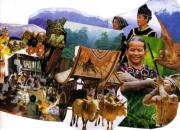Today it is nearly
impossible to know with certainty about the shamans in the northern part of the
Korean peninsula. It seems reasonable, to surmise that shamans in North Korea
were (and perhaps are) of much the same type as those in the northern and
central areas of South Korea. And
since, in the northeast of their language area, speakers of Korean are
neighbors of Manchu, they may also share in the tradition of Manchu shamanism.
There are several terms for shaman in Korean, the most common
being mudang. In its strict sense it designates a female shaman; a male shaman
is called paksu. That mudang is used as common term may reflect the fact that
the majority of shamans are women. In a different sense, mudang is the term for
a shaman by divine and individual calling, a type found in many areas on the
peninsula, but characteristically in the northern and central regions.
Shamans on Cheju Island contrast sharply with this type;
there the office of a shaman, a shimban, is inherited within certain lineages
and is not a matter of divine election. A similar type of hereditary shaman,
known as a tangol, is encountered in the southern regions of the peninsula.
Hereditary shamans, especially the shimban of Cheju Island, cater to a
particular village and its shrine, whereas a mudang gathers a group of personal
followers.
The rituals of Korean shamans are rich in paraphernalia,
dances, and dramatic performances. Rather than being solemn acts, they are
often humorous, and generally both shamans and clients display a practical
attitude. During her spirited performances, a mudang may become the deity that
possesses her, whereas a shimban or tangol primarily pronounces a deity's
message.
Among Japanese shamans, truly dramatic performances are
rather rare, although music may be an important part of a performance. In some
cases, especially when incarnating a deity, the shaman may put on a special
dress, but more often rites are performed in almost everyday attire.
The general technical term for Japanese shamans is miko. In
ordinary parlance today, however, a miko is a young woman serving at a Shinto
sanctuary without being a shaman. Persons who claim some direct relation with
spirits are better known among the populace by local terms. Some of these, such
as yuta, itako, and gomiso, have come to be used as technical terms for certain
types of shamans. Although a special relationship with some spirit is the
hallmark of all shamans, some types can be established by considering the way
this relationship was originally established.
Basically there are two ways that somebody may become a
shaman: either as a result of ascetic training or by divine calling. In the
first case, the future shaman undergoes ascetic training either by his own will
or by the will of relatives. In this manner mountain ascetics, called
yamabushi, undergo austerities in order to acquire magic power over spirits.
Initiatory illness is characteristically the first sign of
the second way to become a shaman, as it indicates a divine calling. Once a
person has acknowledged an illness as spirit induced, the next step is to
engage in ascetic exercises until the spirit reveals its identity. Others may
suddenly be possessed by their future helping spirit, and only later learn how
to control their relationship. The yuta of Okinawa, and the kamisama of Tsugaru
as well as the gomiso, as these shamans may be called in other areas of
northern Japan, are of the same kind.
Among the Ainu of the far north of Japan, both the way of
becoming a shaman and the terms used are so different from the rest of Japan
that some have seen the elements of Eurasian shamanism as most significant
here, as well as in Tsugaru. It was a rich tradition, as the entry "Ainu
Shamanism" makes clear. Two other factors are noteworthy for Japanese
shamans. The first is geographical distribution. Shamans by divine calling may
show local characteristics, but they can still be found throughout the country.
The same may be said of the yamabushi, although, in practice, they form groups
centered on a particular sacred mountain that is the place of their ascetic
exercises. The itako, on the other hand, do represent a local type, since they
are mainly found in northern Japan. The second factor is the role of mountains
as the realm where divine spirits can be met. At a sacred mountain yamabushi
acquire the power to handle spirits. Many future shamans, afflicted by an
initiatory illness, go to a sacred mountain to pursue ascetic training, such as
standing under waterfalls. As a result they encounter there the spirit that is
the source of their illness.
go back to the Shamanism Central
Page:

For updates click homepage here